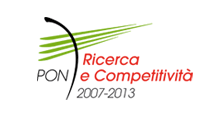Results to date: 08/09/2014
SEGUI IL PROGETTO
The objective of this project addresses efficient, non-invasive lighting of a high chromatic yield, of urban areas of artistic-architectural merit, of art works and valuable property. The aim of the activity is the development of a prototype of light at low energy consumption based on plastic material, or rather organic LED (carbonic atom-based) denominated OLED (Organic Light Emitting Diode). The aim is therefore to guarantee optimal visual return and preserve the integrity of the works contributing at the same time to lowering the energy consumption of the lighting systems of museums, exhibition spaces, churches and other places of high cultural interest.
The prototype which will be the output of this project promises to overcome the current limits of the standard sources used in exhibition environments in terms of chromatic quality and efficiency, being able in future to be introduced into the most widespread sectors of technical lighting. The innovative OLED technology which is developed and optimised in the project presents a series of innovative characteristics both regarding standard lighting sources and with respect to analogous LED and OLED products currently on the market.
With regard to the results achieved during the first phase of activity significant results have been achieved from the point of view of optimisation of OLED on a small emissive area with regard to theoretical analysis on the physics of the devices and improvement of the efficiency of the structure and chromatic characteristics, both important factors for the creation of a final product adapted for application in exhibition environments. To create OLED with efficient white emission and high chromatic quality different micro-cavities were used optically coupled through semi-reflective mirrors, using metal (i.e. aluminium) nanometric planar strata such as mirrors and/or electrodes, alternating with likewise fine strata of electroluminescent organic material.
Furthermore an analysis has been launched around the improvement of the lifespan of OLED, making use of a very stable electroluminescent material. Various approaches were therefore analysed and applied to increase the efficiency and chromatic quality of OLED.
Thanks to this phase devices were created on a small area with high chromatic yield and efficiency superior to the project target obtaining good services also on flexible supports, an important factor to increase the aesthetic and architectural possibilities of the OLED lamps. Market research and a patent analysis were also completed to direct the research towards innovation of the OLED technology for possible productive solutions.
In the pursuit of the project the results achieved will be scaled up on small emissive areas on OLED sources of larger areas, making use of techniques already analysed or potentially to be researched. The best methods to preserve the devices from decay (encapsulation methods) will also be developed and the sources on ad hoc supports will be implemented to permit immediate installation and lighting. These phases will be accompanied by activities for the future transfer of the product on the market and for the creation of contacts for the use of the technology and scientific and productive collaborations. The final output will be made up of OLED lamps with high chromatic quality and high efficiency in the form of large luminescent panels, ultrafine and potentially flexible to be used in all sectors where high quality lighting is required, in particular in museum spaces and exhibition environments.






 Storify
Storify twitter
twitter YouTube
YouTube
